Curious about the symbolic meanings of animals in the Bible? Discover how these creatures convey profound spiritual lessons and moral truths.
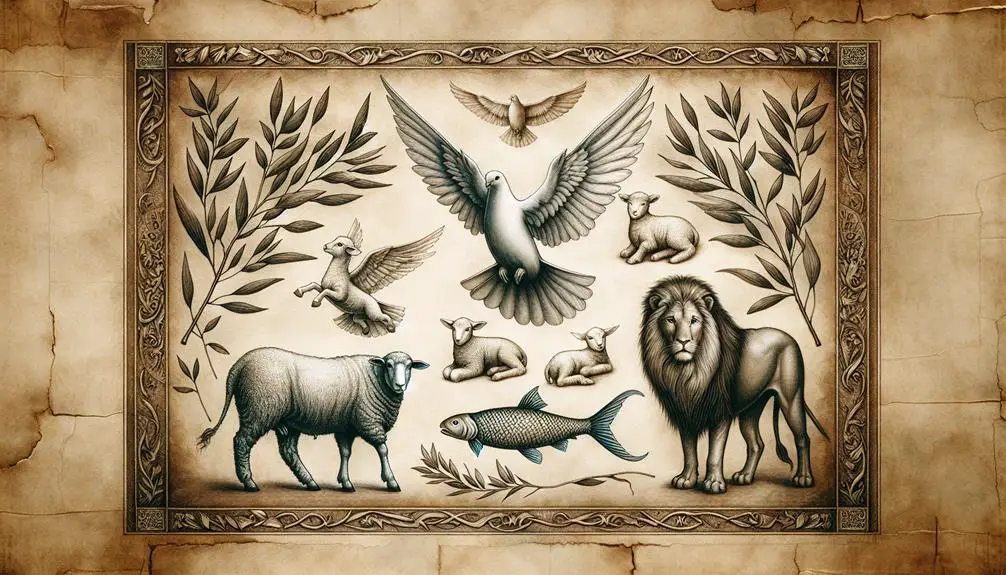
Animals Mentioned in the Bible and Their Meaning
As you're aware, 'a leopard can't change its spots,' and similarly, the animals mentioned in the Bible hold unchanging symbolic meanings that have influenced cultures and beliefs throughout history. You'll find that lions represent strength and courage, while doves symbolize peace and purity.
But have you ever pondered what the less celebrated animals signify, or why the humble lamb is so crucial in biblical narratives? The symbolism woven into these ancient texts extends beyond simple animal imagery, hinting at deeper spiritual truths and moral lessons.
Let's embark on a journey to uncover these meanings, which might just offer a fresh perspective on familiar stories.
Key Takeaways
- Lions in the Bible represent power, divine protection, and authority.
- Doves symbolize peace, the Holy Spirit, and spiritual purity.
- Lambs signify innocence, sacrifice, and ultimate redemption.
- Serpents embody wisdom, temptation, and moral instruction.
The Symbolism of Lions
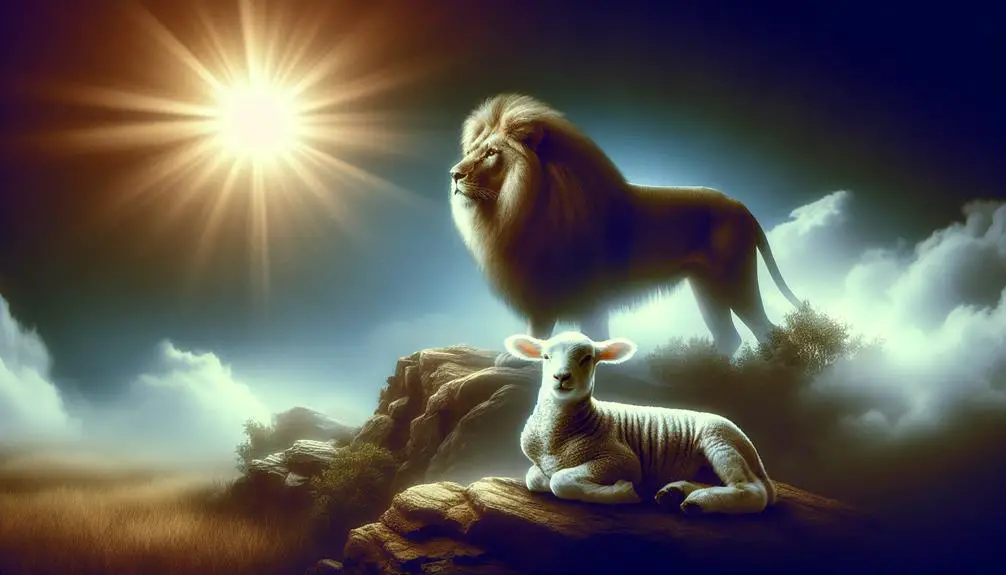
In biblical texts, the lion symbolizes both supreme power and divine protection, reflecting a complex duality in its representation. This majestic creature embodies lion's courage, a trait highly regarded throughout the Scriptures. You'll find that the lion's strength and bravery are often invoked to describe God's protective nature towards His people. For instance, in Proverbs 28:1, it's stated, 'The wicked flee though no one pursues, but the righteous are as bold as a lion.' Here, the lion's courage isn't just a natural characteristic but a symbolic representation of the moral and spiritual bravery expected of the faithful.
Moreover, the lion's role extends beyond mere symbolism of courage to encompass royal symbolism as well. The lion is frequently associated with kingship and authority in the Bible, serving as a metaphor for the power and majesty of God and, by extension, the righteous rulers who are said to be anointed by Him. This association is particularly evident in the Lion of Judah, a title that refers to Jesus Christ, linking the animal's royal symbolism directly to the Messiah's sovereignty and leadership.
Your understanding of the biblical lion thus reveals a multifaceted symbol, one that intertwines the physical prowess and noble spirit of the animal with divine protection and kingly authority. This duality enriches the biblical narrative, offering you a deeper insight into the text's portrayal of divine and moral authority through the lens of the animal kingdom.
Doves: Peace and Purity

Doves, symbolizing peace and purity, play a crucial role in biblical narratives, offering you insights into themes of divine love and innocence. This imagery isn't merely incidental but deeply woven into the fabric of biblical storytelling, reflecting both historical and theological dimensions of dove symbolism. The presence of a dove often signals moments of significant spiritual revelation or transformation, emphasizing the bird's importance as a symbol in religious texts.
To understand the multifaceted role of doves in the Bible, consider the following points:
- Noah's Ark: After the flood, a dove returns to Noah with an olive branch in its beak, signifying the end of God's wrath and the beginning of a new covenant with humanity. This moment encapsulates the dove's dual representation of peace (through the olive branch) and purity (the dove itself).
- Holy Spirit: In the New Testament, the Holy Spirit is depicted as descending like a dove during Jesus' baptism, underscoring the purity and peace inherent in divine presence and approval.
- Sacrificial Use: Doves were often used as sacrifices by those who couldn't afford larger animals, highlighting their association with humility, purity, and accessibility to all, regardless of social status.
- Song of Solomon: The beloved is repeatedly compared to a dove, symbolizing love, innocence, and beauty, further reinforcing the bird's symbolic significance across both Testaments.
Analyzing dove symbolism reveals a layered narrative where peace and purity intertwine, offering profound insights into biblical themes. The dove, especially when paired with an olive branch, becomes a powerful symbol of hope, renewal, and divine grace, enriching your understanding of biblical texts.
The Humble Lamb
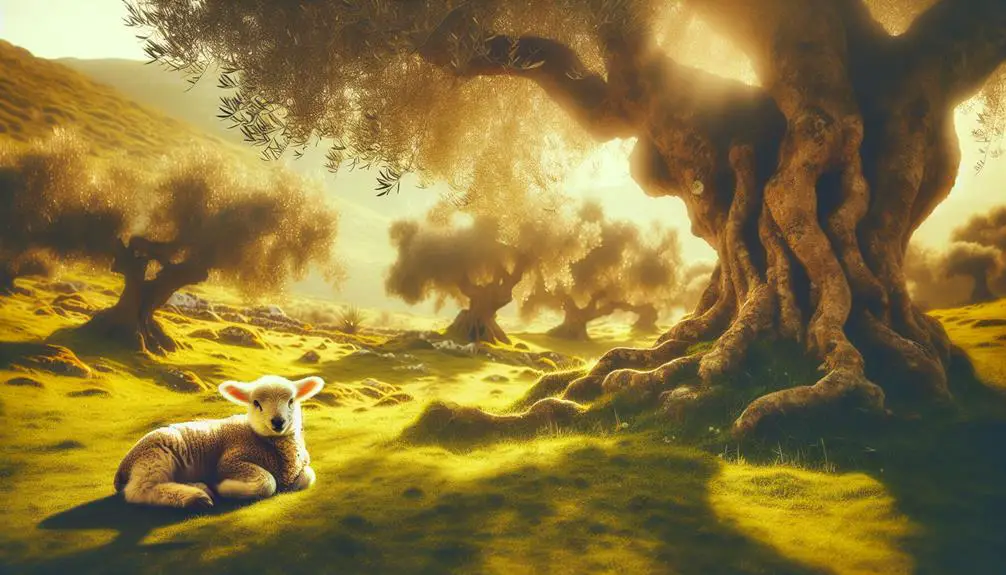
Why does the lamb emerge as a central, humble figure throughout biblical narratives, embodying themes of innocence, sacrifice, and redemption? This question captures the essence of the lamb's profound symbolism in the scriptures. Lamb sacrifices, deeply rooted in ancient practices, serve as a cornerstone of biblical rites and teachings. Historically, these sacrifices were integral to atoning for sins, symbolizing a purity and innocence that could cleanse the impurities of the people. The lamb, in its unblemished state, becomes a vessel for redemption, offering a direct pathway to reconcile with the divine.
Paschal symbolism further elevates the lamb's significance, intertwining it with the story of the Exodus. Here, the blood of the lamb, smeared on the doorposts, becomes a protective sign against divine wrath, a prefiguration of salvation and deliverance. This act not only marks a pivotal moment in Israelite history but also foreshadows the ultimate sacrifice for redemption in Christian theology—the crucifixion of Jesus Christ, often referred to as the Lamb of God. This title encapsulates the embodiment of innocence and the sacrifice for others' sins, solidifying the lamb's role as a symbol of ultimate love and redemption.
Thus, the lamb's recurring presence in the Bible isn't merely a reference to a common animal of the time. Instead, it's a deliberate choice, imbued with layers of meaning that speak to the core of human longing for purity, sacrifice, and salvation. Through the humble lamb, the scriptures weave a narrative of redemption, inviting reflection on the profound depths of divine love and mercy.
Eagles: Strength and Renewal

Throughout biblical narratives, eagles symbolize the formidable strength and promise of renewal that are central to understanding divine intervention and human resilience. These majestic birds, often highlighted for their awe-inspiring qualities, serve as potent symbols within the scriptural context. Their representation is multifaceted, embodying both physical prowess and spiritual enlightenment.
When you delve into the significance of eagles in the Bible, you encounter several layers of meaning that enrich your comprehension of biblical themes. Here's an analytical breakdown:
- Eagle Migrations: These migrations are emblematic of guidance. Just as eagles embark on long journeys, the biblical narrative suggests a divine guidance on life's path, encouraging believers to trust in a higher power during their personal migrations through life's challenges.
- Renewal of Strength: Eagles are renowned for their incredible strength and vitality. This mirrors the biblical promise of renewal for those who wait upon the Lord, suggesting that believers, too, can find new strength in faith.
- Nest Construction: The careful and strategic construction of eagle nests atop high places symbolizes security and perspective. In a spiritual context, it reflects the safety and higher understanding that comes from putting one's faith in divine protection.
- Vision and Clarity: The eagle's keen sight, capable of spotting prey from great distances, symbolizes the clarity and foresight that faith is meant to provide, guiding believers through the obscured terrains of life.
In analyzing these aspects, you gain a deeper appreciation for the eagle's symbolic presence in the Bible, embodying not just physical might but also the spiritual fortitude and renewal that faith promises.
Serpents: Wisdom and Temptation
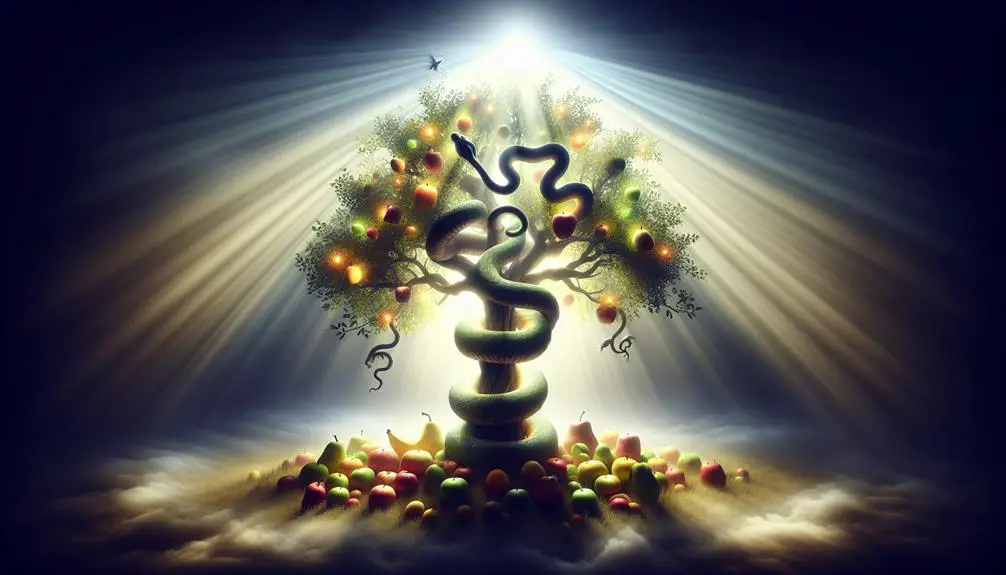
You'll find that serpents in the Bible aren't merely creatures of the earth but embody complex layers of symbolism and moral instruction.
From their pivotal role in Genesis to their depiction as both bearers of wisdom and sources of temptation, serpents serve as cautionary figures within biblical narratives.
This exploration will unravel how these reptiles have shaped theological and ethical discourses.
Serpents in Genesis
In Genesis, the serpent emerges as a pivotal symbol of both wisdom and temptation, challenging readers to delve into its complex role within biblical narratives. This narrative does more than just tell a tale; it invites you to explore the serpent's metaphorical significance against the backdrop of serpent metabolism and reptilian habitats, highlighting a deeper understanding of its symbolic role.
- Serpent Metabolism: Reflects the adaptability and resilience of wisdom amidst challenges.
- Reptilian Habitats: Symbolizes the broad reach of temptation across diverse environments.
- Genesis Context: Offers insights into the serpent's cunning, emphasizing its role as a tempter.
- Reader's Interpretation: Encourages a personal exploration of the balance between wisdom and temptation.
This multifaceted symbol serves as a crucial point of reflection within the biblical text, embodying the perpetual dance between enlightenment and downfall.
Symbolism of Serpents
Building on the serpent's role in Genesis, let's explore its dual symbolism of wisdom and temptation, which further illuminates its significance in biblical narratives.
The serpent, often regarded as a cunning creature, embodies a complex symbol within these texts. Its association with wisdom isn't purely negative; consider the serpent's role in healing narratives, an aspect that ties back to ancient mythological origins where serpents were seen as symbols of renewal and healing.
This duality presents a serpent as both a figure of insight and a harbinger of downfall, encapsulating the intricate balance between enlightenment and the perils of yielding to seduction. The serpent's emblematic presence in these stories underscores a profound commentary on human nature, knowledge, and the tantalizing allure of forbidden wisdom.
Serpents: Cautionary Tales
Delving into serpents' roles across biblical texts reveals a nuanced tapestry of wisdom and temptation, serving as cautionary tales that reflect on the human condition. Serpents, entwined in snake myths and medical symbolism, offer a rich vein of interpretation.
- Serpents as Symbols of Wisdom: Historically, serpents symbolize knowledge, encouraging the pursuit of truth.
- Temptation and Fall: The serpent's role in Eve's temptation underscores the dangers of succumbing to forbidden allure.
- Medical Symbolism: The serpent's depiction on the Rod of Asclepius symbolizes healing, indicating a complex relationship between danger and salvation.
- Narrative Caution: Serpent tales serve as moral compasses, warning against the perils of deception and the virtues of vigilance.
This multifaceted portrayal emphasizes serpents' integral role in conveying vital life lessons.
The Faithful Sheep
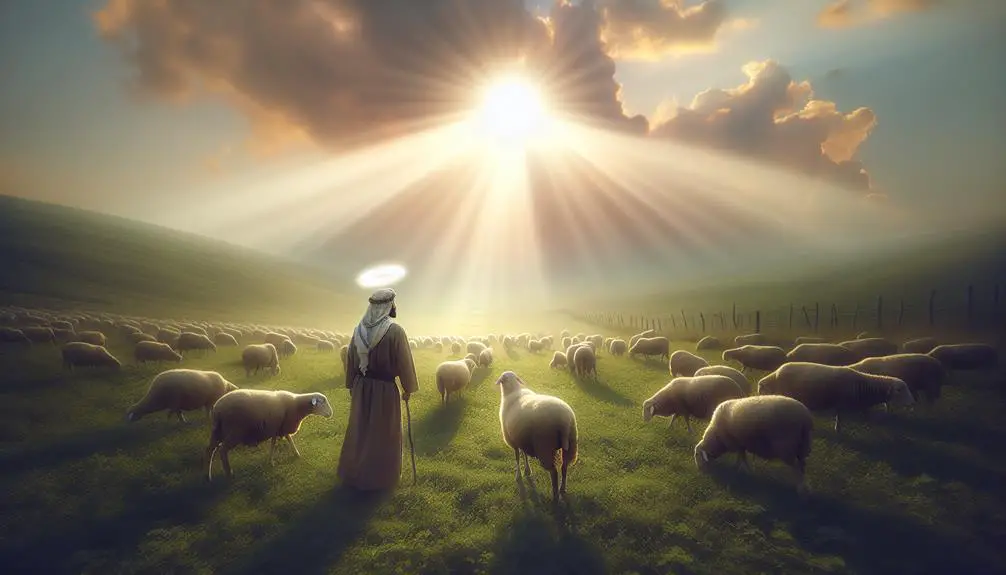
You'll find that sheep hold a unique place within the biblical narrative, symbolizing innocence, purity, and a deep-seated trust in divine guidance.
This symbolic significance is intricately tied to the shepherd-sheep relationship, a dynamic that illustrates themes of guidance, protection, and unwavering faith.
Exploring this relationship offers insights into the broader theological implications of faithfulness and dependence within the biblical context.
Sheep's Symbolic Significance
Throughout biblical scripture, sheep often symbolize faithfulness and the qualities of a devoted follower, embodying the virtues expected of believers. Their portrayal isn't merely coincidental but deeply interwoven with the pastoral economy of ancient times. The significance of wool, for instance, underscores not just economic value but also purity and provision, mirroring the spiritual sustenance believers receive.
Analyzing sheep's symbolic significance reveals:
- Economic Stability: Sheep were central to the pastoral economy, symbolizing material and spiritual prosperity.
- Purity: Wool's whiteness represents innocence and purity, qualities attributed to faithful followers.
- Sacrificial Role: Sheep's role in sacrifices underscores submission and atonement, reflecting a believer's devotion.
- Community: Just as a flock relies on unity, believers are encouraged to live in harmonious communities, exemplifying collective faithfulness.
Shepherd-Sheep Relationship
In biblical narratives, the shepherd-sheep relationship exemplifies guidance and protection, paralleling the dynamic between deity and believers. This relationship isn't just about leading the way; it's a profound display of pastoral care and understanding of flock dynamics. You'll notice that, in scripture, this bond illustrates how guidance and protection are provided, reflecting the unwavering care and attentiveness required from those in leadership roles.
Aspect |
Biblical Interpretation |
Modern Implication |
|---|---|---|
Guidance |
Shepherd leading paths |
Moral and spiritual guidance |
Protection |
Defending the flock |
Safeguarding faith and wellbeing |
Care |
Searching for lost sheep |
Personal and communal support |
Understanding |
Knowing each sheep by name |
Recognizing individual needs |
Analyzing this relationship reveals the deep layers of commitment, care, and understanding that form the foundation of spiritual leadership and communal living.
Ravens: Providence and Survival

Ravens, often depicted as mere background characters in ancient texts, play a pivotal role in biblical narratives, embodying themes of providence and survival. These birds, renowned for their intelligence, emerge not just as creatures of the air but as pivotal symbols interwoven with human stories of faith and endurance. The biblical accounts highlight raven intelligence and their cultural representations, offering a deeper, symbolic understanding of their roles.
Here's an analytical exploration of ravens in the Bible:
- Raven Intelligence: Renowned for their problem-solving abilities, ravens in biblical stories are depicted as agents of God's providence. Their capacity to understand and act in complex scenarios underscores their significance beyond mere birds, embodying divine intervention and care.
- Cultural Representations: In various cultures, ravens are seen as harbingers of both doom and hope. In the biblical context, however, they represent God's unexpected means of provision, challenging the readers to see God's hand in surprising places.
- Symbolism of Survival: The feeding of the prophet Elijah by ravens during a drought (1 Kings 17) exemplifies survival through divine provision. This narrative showcases the raven as a symbol of God's sustenance in times of hardship and scarcity.
- Providence in Nature: Ravens, by their natural behaviors, remind humans of the providential care embedded within creation. Their roles in the biblical stories encourage a reflection on how survival often depends on attentiveness to the natural world and its Creator.
In exploring these aspects, one gains a richer understanding of how ravens, through their intelligence and cultural representations, embody profound biblical themes of providence and survival.
Behemoth and Leviathan: Cosmic Battles

Behemoth and Leviathan, as depicted in biblical texts, often symbolize the immense cosmic battles that underscore human understanding of divine justice and chaos. These creatures aren't just animals; they're monumental figures in a narrative that explores the boundaries of creation and destruction, order and disorder. You'll find that ancient interpretations of these beings offer a window into how early societies conceptualized the world around them, especially the unseen forces at play.
In the context of marine mythology, Leviathan holds a special place. This sea monster represents the untamed and chaotic nature of the oceans, a theme prevalent in the lore of many ancient cultures. It's not just a creature but a symbol of the primordial chaos that predated creation, according to biblical narratives. The Leviathan's counterpart, Behemoth, embodies the land's untameable wildness, standing as a parallel force that balances the cosmic scales of chaos and order.
Scholars have long debated the exact nature of these entities, suggesting that their descriptions in ancient texts serve not only as literal depictions but also as metaphors for natural disasters, political upheaval, or even the internal struggle between good and evil. This analytical perspective reveals the depth of meaning behind these biblical monsters, illustrating the complexity of human attempts to understand the divine and the chaotic elements of existence.
Understanding Behemoth and Leviathan through the lens of ancient interpretations and marine mythology allows you to grasp the nuanced ways in which these cosmic battles were conceptualized, reflecting a deep engagement with the mysteries of the natural and spiritual worlds.
Frequently Asked Questions
How Do Modern Interpretations of Animals in the Bible Differ From Traditional Views?
You'll find that modern interpretations of biblical animals often diverge from traditional views due to evolving cultural and societal norms. Symbolic interpretations now encompass broader themes, reflecting current ethical and environmental concerns.
Modern controversies also arise as scholars debate the historical accuracy and metaphorical significance of these animals. This analytical shift highlights a growing desire to reconcile ancient texts with contemporary values, leading to richer, more contextual understandings.
Are There Any Animals Mentioned in the Bible That Are No Longer Identifiable or Existent Today?
You're peering into a world where translation challenges and mythical creatures blur the lines of history. Some animals cited in ancient texts now elude clear identification, hinting at beings that either no longer exist or were never real.
Analytically, this dilemma showcases the evolution of language and myth within scholarly studies. It's a reflective journey into how our understanding of these creatures is continually reshaped by new findings and interpretations.
How Do the Representations of Animals in the Bible Influence Contemporary Animal Conservation Efforts?
The representations of animals in the Bible play a significant role in shaping contemporary animal conservation efforts. Through ethical stewardship and religious symbolism, you're encouraged to view animals not just as creatures, but as integral parts of creation that require protection.
This perspective fosters a deeper understanding and commitment towards conservation, as it aligns with the moral and spiritual values found in biblical teachings, urging you to act responsibly towards all living beings.
Can the Mention of Certain Animals in the Bible Be Linked to Specific Historical or Cultural Contexts of the Time?
You're barking up the right tree asking if biblical animal mentions tie to specific contexts of the time.
Analyzing animal symbolism and geographic distribution sheds light on this. These animals weren't chosen at random; their inclusion reflects historical, cultural, and environmental realities of the era.
How Do Non-Christian Religions Interpret the Same Animals Mentioned in the Bible?
You're delving into how non-Christian religions interpret biblical animals, focusing on Islamic parallels and Hindu symbolism.
In Islam, many animals share symbolic meanings with their biblical counterparts, reflecting similar moral and spiritual lessons.
Hinduism, however, often imbues these creatures with distinct attributes, rooted in its vast mythological tapestry.
This exploration reveals the rich, varied interpretations across cultures, highlighting the universal significance of animal symbolism in human spirituality and moral guidance.
Conclusion
In the tapestry of biblical narratives, animals aren't merely background characters; they're richly woven symbols, each thread imbued with profound meaning. From the lion's majestic roar echoing divine authority, to the dove's gentle coo whispering peace, these creatures serve as mirrors reflecting our deepest virtues and vices. They guide us through the wilderness of moral quandaries, reminding us that wisdom often slithers in unexpected forms.
Thus, in the biblical menagerie, every beast, from the humble lamb to the cosmic Leviathan, carries a celestial message, teaching us about the divine, the earthly, and the intricate dance between them.

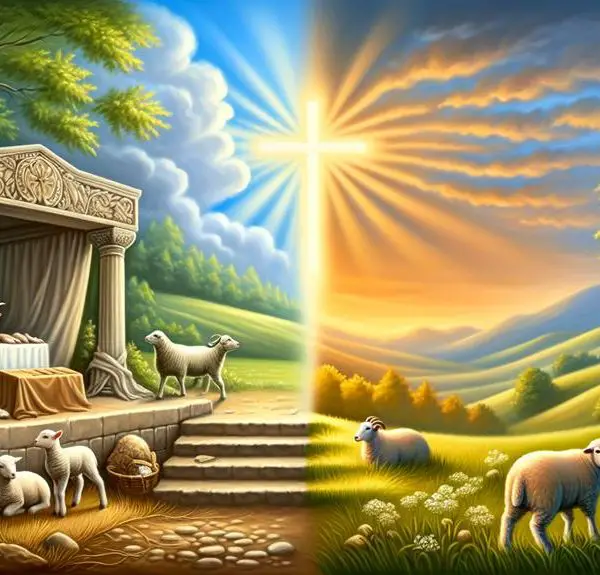

Sign up